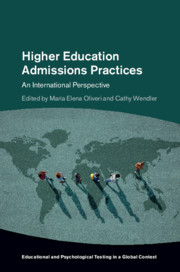Book contents
- Higher Education Admissions Practices
- Educational and Psychological Testing in a Global Context
- Higher Education Admissions Practices
- Copyright page
- Contents
- Figures
- Tables
- Contributors
- Series Editor’s Foreword
- Foreword
- Acknowledgments
- Part I Global Challenges and Common Admissions Models
- Part II Country-Specific Admissions Practices
- Part III Assessments Used in Higher Education Admissions
- Part IV Rethinking Higher Education Admissions
- Index
- References
Part III - Assessments Used in Higher Education Admissions
Published online by Cambridge University Press: 09 January 2020
- Higher Education Admissions Practices
- Educational and Psychological Testing in a Global Context
- Higher Education Admissions Practices
- Copyright page
- Contents
- Figures
- Tables
- Contributors
- Series Editor’s Foreword
- Foreword
- Acknowledgments
- Part I Global Challenges and Common Admissions Models
- Part II Country-Specific Admissions Practices
- Part III Assessments Used in Higher Education Admissions
- Part IV Rethinking Higher Education Admissions
- Index
- References
Summary
The chapters in this part provide an overview and critical discussion of the types of assessments used to help inform admissions decisions. Examples include assessments that measure academic preparation (either general or subject-specific skills), tests of language proficiency, and assessments of noncognitive and personality traits. These assessments may or may not be required of all applicants, depending on the type of institution students apply to, educational model higher education institutions use, and rigor of the admitting institution’s selection criteria, among other factors.
Keywords
- Type
- Chapter
- Information
- Higher Education Admissions PracticesAn International Perspective, pp. 233 - 302Publisher: Cambridge University PressPrint publication year: 2020



